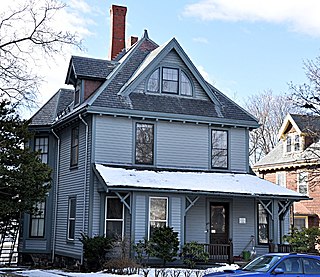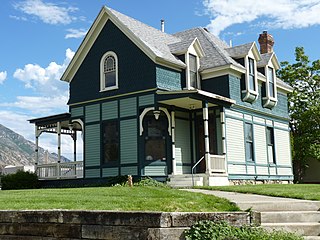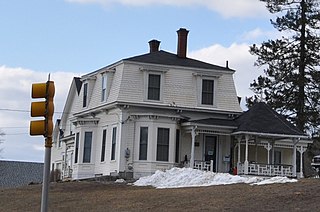
The William H. Roberts House is a late 19th-century house located in Pecatonica, Illinois, United States. The house was built in 1883 for Dr. William H. Roberts, who died three years later at the age of 33. The building features a combination of elements from three distinct architectural styles, Italianate, Queen Anne and Gothic revival. The building functioned as both Roberts's house and office. The house is the only building in Pecatonica listed on the United States National Register of Historic Places, a status it attained in 1979.

The Walter S. and Melissa E. Barnes House is a historic house at 140 Highland Avenue in Somerville, Massachusetts. Built about 1890, it is one of the city's least-altered examples of Queen/Stick style Victorian architecture. It was for many years home to Robert Luce, a one-term Lieutenant Governor of Massachusetts. It was listed on the National Register of Historic Places in 1990.

The House at 9 White Avenue in Wakefield, Massachusetts is a well-preserved transitional Queen Anne/Colonial Revival house. Built about 1903, it was listed on the National Register of Historic Places in 1989.

The William V. N. Barlow House is on South Clinton Street in Albion, New York, United States. It is a brick building erected in the 1870s in an eclectic mix of contemporary architectural styles, including Second Empire, Italianate, and Queen Anne. Its interior features highly intricate Eastlake style woodwork.

Queen Anne style architecture was one of a number of popular Victorian architectural styles that emerged in the United States during the period from roughly 1880 to 1910. Popular there during this time, it followed the Second Empire and Stick styles and preceded the Richardsonian Romanesque and Shingle styles. Sub-movements of Queen Anne include the Eastlake movement.

The Hunter–Morelock House is a historic house located at 104 Holmes St. in Wallowa, Oregon. The house was built in 1903 for Charles A. Hunter, a Wallowa politician and businessmen; it was later purchased by J. P. Morelock, one of the founders and later mayor of Wallowa. The house's design incorporates the bungalow and Queen Anne styles; the design includes a veranda, a hip roof with a small dormer, and a double-hung sash central window. The dormer is trimmed in Eastlake style trim, and art glass is used extensively in the entrance and several interior windows.

The Delavan Terrace Historic District is located along the street of that name in Northwest Yonkers, New York, United States. It consists of 10 buildings, all houses. In 1983 it was recognized as a historic district and listed on the National Register of Historic Places.

The William D. Alexander House is a historic house located in Provo, Utah. It is listed on the National Register of Historic Places. It is asserted to be the only period example of Stick Style architecture in the state of Utah.

Samuel Warden House is a historic home located at Mount Pleasant, Westmoreland County, Pennsylvania. The house was built in 1886, and is a three-story, square brick dwelling in the Second Empire style, with Queen Anne and Eastlake style details. It has a mansard roof clad in octagonal, fishscale slate with dormer windows.

The Robert L. Douglass House, at 10 S. Carson St. in Fallon, Nevada, United States, was built in 1904. It has been described as an "outstanding" example of Queen Anne architecture. The property also includes a structure known as the Cottage Hospital and the Fallon Hospital, it was listed on the National Register of Historic Places in 2001. The listing included two contributing buildings.

The Charles S. Hall House is a historic house at 1740 Dover Road in Epsom, New Hampshire. Built c. 1890, it is the only Second Empire building in the town, adorned further with Queen Anne features. The house was listed on the National Register of Historic Places in 2002.

The Robert L. Dulaney House is a historic house located at 602 North 7th Street in Marshall, Illinois.

The John C. Anderson House is a historic house located at 920 W. Breckenridge St. in Carlinville, Illinois. The house's first floor was built in 1883, while its second floor was added in 1892. The first floor has an Italianate design featuring tall, narrow windows, an asymmetrical porch with paired columns, paired brackets, and a dentillated cornice. The second floor is designed in the Queen Anne style and includes a square tower with stick style framework, a multi-component roof with gabled dormers, and a stained glass window with a decorative wooden frame. Local banker C.H.C. Anderson built the house for his son John C. Anderson as a wedding gift; John and his wife Lucy lived in the house until their deaths in the 1930s.

The Chambers–Robinson House is a historic house located at 910 Montgomery Avenue in Sheffield, Alabama.

Nappanee Eastside Historic District is a national historic district located at Nappanee, Elkhart County, Indiana. The district encompasses 138 contributing buildings in a predominantly residential section of Nappanee. It was developed between about 1880 and 1940, and includes notable examples of Italianate, Queen Anne, Colonial Revival, and Prairie School style architecture. Located in the district are the separately listed Frank and Katharine Coppes House and Arthur Miller House.
The E.J. Baird House is a historic building located in Millersburg, Iowa, United States. Baird was a prominent citizen here in the late 19th and early 20th centuries. He grew very wealthy through his involvement in commerce, banking, and farming. Baird operated a very successful general store in Millersburg, which was the primary source of his income. His 2½-story frame house is an outstanding example of Victorian "pattern book" architecture, with influences from the Victorian Gothic, Queen Anne, and Eastlake styles. The Victorian Gothic is found in the vergeboard on the gable ends. The Queen Anne style is found in the two-story projecting bay that is capped with a pyramid-shaped roof. The Eastlake influence is more dominant than the others. Its decorative influence is found in the sunburst on the projecting front dormer, the decorative brackets along the eaves, and the large porch with its lattice-like base, spindle balustrades, and turned posts. The house was listed on the National Register of Historic Places in 1982.

The Martin House is a historic house located at 707 10th Avenue in Fulton, Illinois. The Italianate house was built in 1855, when the style was becoming popular nationally. The house features a hip roof with bracketed eaves, tall windows, and a bay window on the east side, all distinctive Italianate elements. A wraparound front porch, a Queen Anne element, was added circa 1898. A 1908 renovation of the entry hall and dining room added Eastlake elements to the former and gave the latter an Arts and Crafts design.
The Funk House, located at 523 North Cary Avenue in Jennings, Louisiana, is a historic house with elements of Queen Anne and Eastlake architectural styles.

The East Michigan Avenue Historic District is a residential historic district located at 300-321 East Michigan Avenue, 99-103 Maple Street, and 217, 300 and 302 East Henry in Saline, Michigan. It was listed on the National Register of Historic Places in 1985.

The North Ann Arbor Street Historic District is a residential historic district, consisting of the houses at 301, 303, and 305-327 North Ann Arbor Street in Saline, Michigan. It was listed on the National Register of Historic Places in 1985.




















